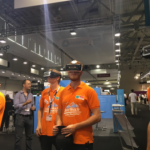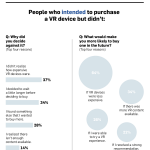Google VR For Android Poised To Create New Reality For Online Advertising
by Laurie Sullivan @lauriesullivan, July 20, 2016

It appears the success of the Pokémon Go game convinced Google co-founders Larry Page and Sergey Brin that the parent company, Alphabet, no longer needs a “standalone” virtual reality headset to compete with the likes of Facebook’s Oculus and HTC’s Vive.
Google simply needs to build the technology to explore another reality — whether augmented or virtual — into the Android operating system running on mobile devices, which most people carry with them wherever they go.
Not surprisingly, consumers find VR content engaging. Data from StartApp and Fibrum found consumers spend about 30 seconds within mobile VR ad units.
While AR requires computer vision and dynamic mapping of the real world, virtual reality creates a computer-generated simulation that people can interact with.
Advertisers and their agency partners are just looking for another experience. “AR is innovation that marketers should use now, whereas VR is innovation for tomorrow, according to Rob Griffin, chief innovation officer at ad agency Almighty. “AR is where it’s at, especially with mobile, because there is so much potential,” he said.
Griffin believes Google will tie AR into the phone and use the data to improve targeting, but their issue is fragmentation. “This makes it more difficult for designers and producers of the apps to implement the technology,” he said. “Apple will kill them here due to the simplicity of the ecosystem.”
Overall, investments in VR and AR rose from $144 million during the first quarter in 2015 to more than $1 billion in the first quarter of 2016, according to CB Insights, which tracks investments in VR and AR.
Google’s Next Move
One report suggests that Google recently shut down an internal project to create a high-end stand-alone VR headset, and will shift more of its resources behind mobile VR. Rather than expensive hardware, Google’s putting more resources behind tools so companies can build apps, games and services on smartphones. No doubt those services will include advertising.
Eric Klopfer, professor and director of the Scheller Teacher Education Program and the Education Arcade at MIT, reminds us that print advertising already taps the technology. He explained in an email that it’s done through the use of QR codes or through increasingly improving image recognition, even overlaying content can be triggered and displayed. “NFC, while not as ubiquitous, is another way to trigger such content,” he wrote.
As Google finds ways to make VR part of the function on a mobile phone, the company will likely take the technology into advertising on publisher sites. In May released Daydream, a platform and reference design for new VR hardware build on the latest version of Android that’s more advanced than its Cardboard headset.
If Google can make virtual reality work within Daydream the company can, once again, revolutionize advertising by turning any publisher’s site into another experience for those viewing the content on the page through an Android device.
MediaPost.com: Search Marketing Daily
(17)













